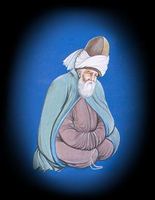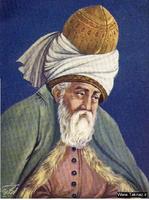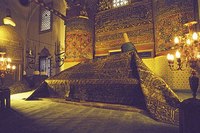Mawlana (Rumi)
Mawlawi, Jalal al-Din Muhammad ibn Sultan al-‘Ulama’ Baha’ al-Din Muhammad Balkhi (Rumi) (1207-1273), a mystic, Sufi, theologian, and poet well-known as Mawlawi, Mawlawi-yi Ma’nawi, Mulla-yi Rumi, Mawla-yi Rum, and Mawlana-yi Rumi, bearing the titles Khudawandigar and Jalal al-Din, who at times used the nom de plume Khamush. He was born in Balkh, but his designation ‘Rumi’ is owing to his prolonged stay and death in Konya (Quniyya). His prolonged stay in Rum (Anatolia) won him the appellation Jalal al-Din Rumi. He used the nom de plum Khamush. His genealogy on the paternal side traces back to Abu Bakr Siddiq, hence the designation Bakri applied to his family. His family lived in Wakhsh and Samarqand for some time. His father, Muhammad ibn Husayn Khatibi was well-known as Baha’ al-Din Walad and bore the title Sultan al-‘Ulama’. His grandmother on the paternal side was the granddaughter of the Khwarazmshah Sultan ‘Ala’ al-Din Muhammad. Baha’ al-Din was known in Balkh as a well-spoken teacher and preacher and mystic and was well-respected by the Khwarazmshah Sultan Muhammad, but incurring an offence by the Sultan, he departed from Balkh with his son, Jalal al-Din, a five or six year old child and emigrated westwards and traveled to Nishabur, Baghdad, Mecca, Syria, and Arzanjan. Then, he departed Arzanjan to go on pilgrimage to Mecca. Mawlawi stayed in cities in Asia Minor with his father. After four years, Sultan Walad, together with his father and his son, departed for Konya at the suggestion of the Seljuk Sultan ‘Ala’ al-Din Kayqubad and settled there. Upon his return from his pilgrimage to Mecca, he married in Larinda Gawhar Khatun, daughter of Sharaf al-Din Lala, at the suggestion of his father and four years later, the father and the son migrated to Konya at the behest of the Seljuk Sultan of Asia Minor. She bore him three sons and a daughter. One of his sons was Sultan Walad. After the death of his father, Mawlawi continued in 1230 his studies under Burhan al-Din Muhaqqiq Tirmidhi, Baha’ Walad’s former student. He furthered his studies at the Jalaliyya School in Aleppo at the suggestion of Burhan al-Din where he studied under Kamal al-Din Ibn ‘Adim, the distinguished Hanafi jurist. Then, he departed for Damascus where he studied Hanafi jurisprudence by studying Marghinani’s Hidaya and met Muhy al-Din Ibn al-‘Arabi. He traveled in 1232 and returned to Konya in 1239 and continued his Sufi ascetic practices until he was ordered by Muhaqqiq Tirmidhi to provide disciples with guidance and upon his master’s death in 1233, he succeeded his master’s teaching position. He conversed with Shams Tabrizi in 1244, but after the disappearance of Shams in 1248, Mawlawi turned towards Shaykh Salah al-Din Zarkub and felt the same mystic passion in his meeting with him. Mawlana was attracted to Salah al-Din for ten years (1249-1258) such that seventy passionate ghazals of Mawlawi are adorned by his name. After the death of Salah al-Din, Mawlana’s restless spirit turned towards Husam al-Din Chalabi who was from a family of spiritual chivalry (futuwwa) and served as the main inspitation for the composition of Mawlawi’s Mathnawi, the fruit of Husam al-Din’s devotion and companionship of Mawlana for 15 years. It is reported that Husam al-Din Chalabi ‘became the master of the masters of spiritual purity.’ Mawlana associated with scholars, Sufi shaykhs, and literati, like Sadr al-Din Muhammad ibn Ishaq Qunawi, Qutb al-Din Mahmud Shirazi, Baha’ al-Din Qani’i Tusi, Qazi Siraj al-Din Urmawi, and Safi al-Din Hindi. His disciples include Mu’in al-Din Parwana, the Mongol designated ruler of Asia Minor who attended the sermons of Mawlana, parts of Fihi Ma Fih, a summary of Mawlawi’s sermons, are addressed Parwana. The inhabitants of Konya, even Jews and Christians, mourned at his funeral procession. His body was laid to rest at their family tomb beside his father. A shrine was erected there which is famous as the ‘Green Dome’ (Qubbat al-Khazra’), the ‘Sultan’s Garden’ (Bagh-i Sultan), and the ‘Paradise Garden’ (Iram Baghcha). Mawlawi had a Sufi spiritual center (khanaqah) built in the city of Konya where he provided people with spiritual guidance. The center grew into a great organization which served as the greatest pillar of Sufism. Some of his disciples who had received Mawlawi’s guidance following his spiritual development and the disappearance of Shams became famous as the Mawlawiyya whose members promulgated their Sufi teachings in Asia Minor and other lands. Mawlawi’s poetical compositions include the Mathnawi, well-known as Mathnawi-yi Ma’nawi, in six volumes (daftars) running to 26,000 couplets; Kulliyyat-i Shams, also entitled Shams al-Haqa’iq and Diwan-i Kabir, including his ghazals, running to about 36,000 couplets; Ruba’iyyat, a collection of 1,659 quatrains. His compositions in prose include: Makatib, his correspondence with his contemporaries; Fihi Ma Fih; Majalis-i Sab’a. Fihi Ma Fih is a collection of his most valuable sermons collected by a disciple or by his son, Baha’ al-Din. The book is not entitled as such by Mawlana, hence the other title Asrar-i Jalaliyya. The arrangement of the material completely follows Kitab al-Ma’arif by Baha’ al-Din Walad, Mawlawi’s father in which some topic, event, some exposition of a formerly discussed topic, or an interpretation of a Qur’anic verse or hadith opens the discussion which then proceeds to further treat of other topics of a miscellaneous nature, though at times, the discussion opens without any introduction. The prose style of the work is quite fluent and clear, reflecting that it is based on spoken rather than written discourse, something unsurpassed in other works of Mawlana. It includes didactic materials concerning the mystical truths and exquisite discussions of a diverse nature raised in his presence or produced by his meditations to which devoted expositions. Majalis-i Sab’a is a collection of seven Sufi séances where shaykhs delivered sermons which were recorded by disciples. Such Sufi works are extant. Mawlana’s Majalis is fluent and intertwined with diverse mystical themes and expositions and Sufi interpretations of Qur’anic verses, embracing numerous prophetic traditions, proverbs, and Arabic and Persian verses. Makatib, a collection of his correspondence, is the most original of his prose works in a more embellished and more vigorous prose style. His prose style is simple and appealing and similar to the works of Sufi shaykhs, it is interspersed with Qur’anic verses, hadith, and poetry. Mathnawi, his magnum opus in six volumes is composed in the meter of ramal musaddas maqsur or mahdhuf (fa’ilatun fa’ilatun fa’ilun, -u- -/-u- -/-u-). His second greatest work, the Diwan-i Kabir, also entitled Diwan-i Ghazaliyyat-i Shams-i Tabrizi, is imbued with exalted mystical truths, agitated oceans of the poet’s most elevated ideas and feelings entailing many ups and downs. His tone in these ghazals reflects his intense passions felt by the skilful poet at different occasions in all of which he speaks about an invisible and unattainable beloved whom he found and met and with whom he conversed about his separation and passion for union. His diction is simple, unaffected, unadorned, exalted, vigorous, clear, and free from ambiguity, but notwithstanding such simplicity his skilful use of the language indubitably ranks him with the most distinguished Persian poets. In his expositions of the details and different states of mind of the characters of his tales and anecdotes and in his expounding the intricacies of mystical themes, he skilfully makes use of the allegories, tales, and proverbs which were in common usage in his times to provide his audience with expositions. His vast knowledge of religious sciences, literature, mysticism, and folklore is astounding. His particularly astounding diction appealing to everybody from any background is impressed by the poets of Khurasan. The horizons of Mawlawi’s intuitive vision are so vast that they join pre-eternality and eternality and make a depiction vast as existence. His imagery give birth the organic develpoment of the most profound and vast themes. The elements constituting his poetry are themes like death and life, resurrection, pre-eternality and eternality, sea, and mountain. Mawlawi’s poetry is generally marked up by the devises of the constituting the couplets of the ghazals; non-adherence to aesthetic principles and adherence to formal and technical observations; deconstruction in the poetical forms; extreme prolongation and brevity of the ghazals. Mawlawi’s mystical views and school of thought are mainly based on love. He maintains that existence stems from love and love is the standard of life. He emphasizes that there should exist a harmony between knowledge and practice and such knowledge may not be manifested without the master’s guidance. A mystic and poet driven to dance by mystical ecstasy, Mawlawi was one of the greatest of the lovers of life. He was profoundly insightful as to the nature of man. The eight hundredth birthday of this great poet, mystic, and thinker of world renown was held in different countries in 2007 at the suggestion of UNESCO.
Asar-afarinan (5/ 309-310); Tarikh-i Adabiyyat dar Iran (3/ 448-486, 1205-1207); Justuju dar Tasawwuf (273-307).



 In association with The Iran Heritage Foundation © All rights reserved 2025. Jane Lewisohn | Website by
In association with The Iran Heritage Foundation © All rights reserved 2025. Jane Lewisohn | Website by